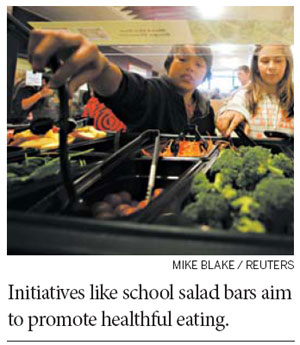Making healthy food trendy
Updated: 2011-11-13 06:59
By Lyndsey Lewis (The New York Times)
|
|||||||||
Critics of the war on bad eating habits often deride it as a game for the rich and Michelle Obama. While it is tough to dispute the benefits of a healthy diet, some naysayers perceive efforts to encourage wholesome eating as an infringement on personal rights.
|
|
No one is revoking the freedom to eat greasy food. But with waistlines expanding around the world, and diabetes and heart disease climbing, the pursuit of better eating habits is transcending class and socioeconomic lines.
Some of the blame for the spread of obesity is linked to the proliferation of American-style food. In many places, diets once rich in fruits, grains and vegetables now include hamburgers and French fries. Mrs. Obama, who has defied steep odds to make vegetables trendier in the United States, wants to extend her push for healthier eating beyond U.S. borders, The Times reported.
Obesity "is becoming an international issue," Mrs. Obama said earlier this year, announcing her plans to spread her message of diet and exercise globally. Meanwhile, there are several initiatives aimed at changing the way Americans eat.
A new program called FoodCorps focuses on improving food quality for children. FoodCorps participants are dispatched to communities where childhood obesity is common, The Times reported. This year's volunteers are working in 10 states, promoting nutrition and fighting for better options in school cafeterias.
|
|
"I'd be even more elated if there were 50 FoodCorps members in each state," Mark Bittman wrote in The Times. Young people are not the only ones who might be seeing more leafy greens on their plates. In the Mississippi Delta, The Times reported that religious leaders are encouraging the faithful to challenge some longstanding Southern traditions. Those often include fried chicken and macaroni heavy on cheese and cream.
Mississippi has a higher percentage of obese children than any other state, according to the Kaiser Family Foundation, and it ranks second in the United States for adults with diabetes. To combat these grim statistics, churches that have typically served fattening foods in the past are now offering fruits and vegetables.
The idea is that community institutions should serve as catalysts for change. "I'm not going to say it has to be done by the church," the Reverend Kevin Wiley, a pastor in Mississippi, told The Times. "But it has to be done by people within the community."
For the next generation of Mississippians, traditional treats may not be the main culprit. Johnnie Carter, who promotes better eating habits at her church, told The Times that fast food restaurants can pose a bigger draw for young people. After all, those restaurants serve food that is often cheap and convenient to buy, but that doesn't mean home cooking is doomed. Some people are finding that inexpensive food can also be healthy and homemade.
And even better than homemade is homegrown. One positive influence of the sour economy is that more Americans are growing their own vegetables, The Times reported. While saving money, these novice gardeners are also eating fresher. There are other perks to gardening as well, including stress reduction. Brenda Engle, who works at an apparel factory, has grown beans with her husband and finds it relaxing. "When I'm in the garden," she told The Times, "the world is gone."
For comments, write to nytweekly@nytimes.













